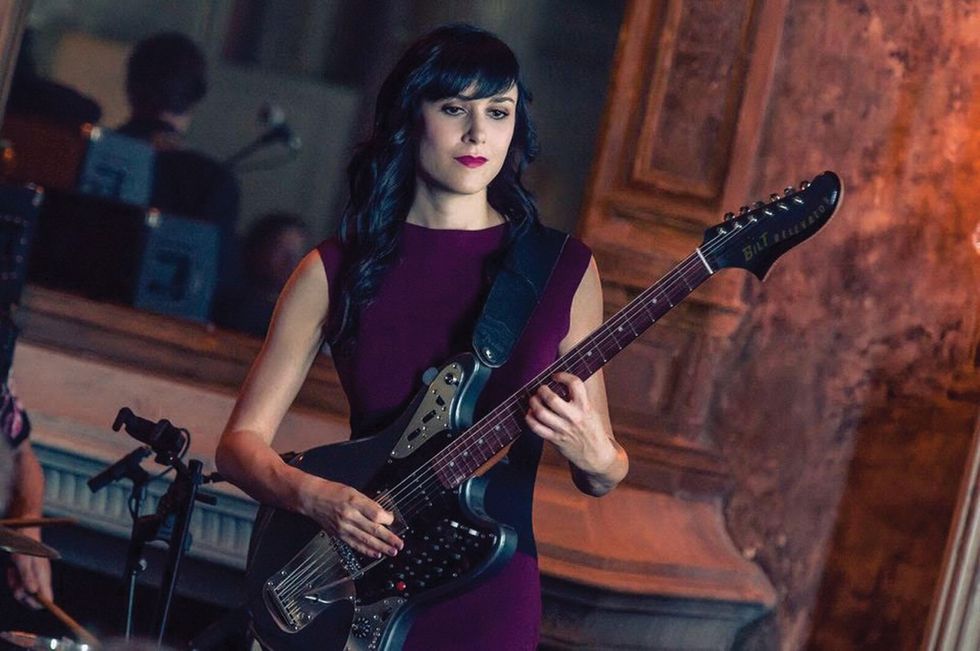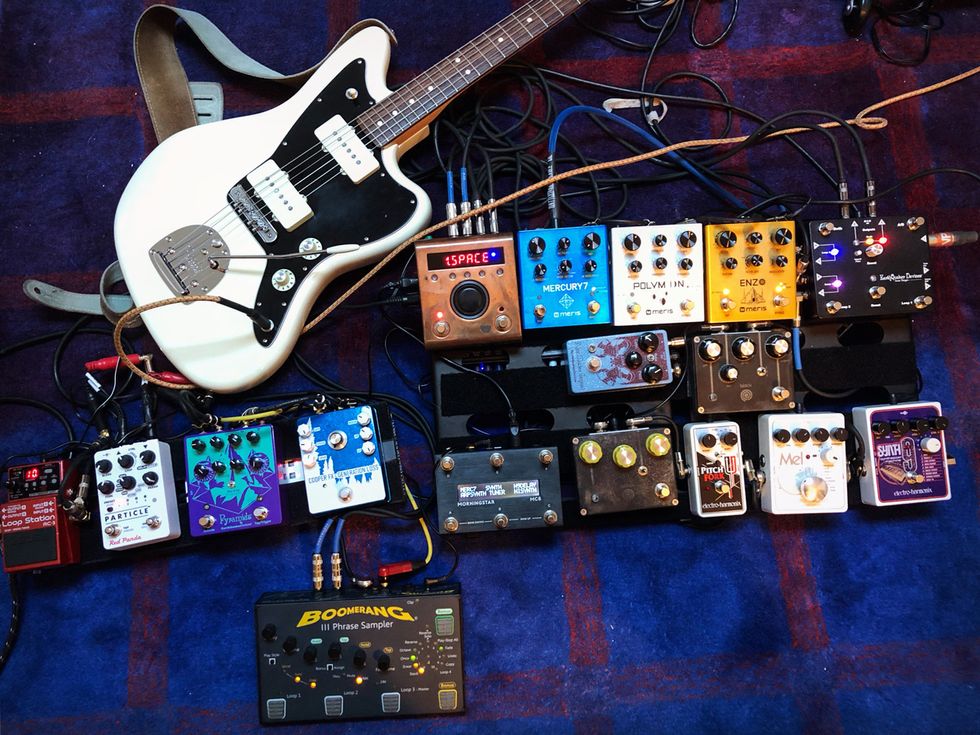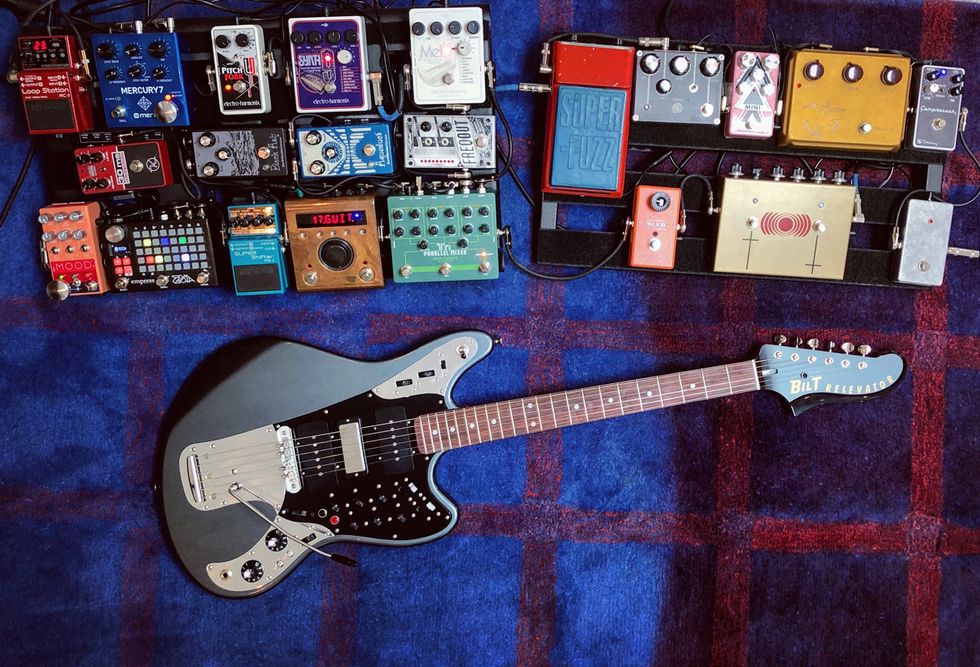Guitarist and composer Sarah Lipstate works under the name Noveller and creates luscious, expansive soundscapes with a guitar, an amp, and an overwhelming array of pedals. Her looped textures are mood-inducing works of art. They conjure up images of wide-open spaces and infinite horizons, and, despite their electronic origins, they evoke an organic, meditative space.
Although Lipstate is a guitarist, it may be more accurate to say that her principle instruments are pedals. She works with a mind-boggling number of devices. We discussed almost 40 in the course of our conversation, and that's just scratching the surface. She also uses a cello bow and copious amounts of rosin, mechanical bowing tools, and a custom BilT Relevator guitar with three circuit boards built into it. She uses pedals to get her creative juices flowing, and they're often her point of reference as she moves through the creative process—at least until it comes time to name her compositions.
“When I'm writing these pieces, I start up a session in Logic Pro, and then I have to come up with a file name to save the sessions," Lipstate says. “Usually, the initial session is named after whatever pedals I'm using." For example, one song on her latest release, Arrow, is built around the Montreal Assembly 856 for ZELLERSASN. The file in Logic was saved as, “ZELLERSASN," which, by the time the album was finished, had morphed into “Zeaxanthin."
“When the record is done, I can't have all these tracks named after guitar pedals," she laughs. “For that track, I was visiting my parents, and I asked them to help me come up with a word that starts with a Z, which is similar to ZELLERSASN, but different. My parents are really into crossword puzzles and word jumbles, and my mom found zeaxanthin. It's a cool word. I found it to be aesthetically pleasing and exciting, and that piece on the record is the one I'm probably most proud of, and I thought the name fit." (For the curious, zeaxanthin is an alcohol found in paprika, corn, and other plants.)
Tongue-twisting song titles aside, Arrow is a collection of what Lipstate does best. The album features eight original compositions that loop layer on top of layer, drawing from a palette of sounds so broad that at times you forget they were generated by a guitar—although, she will, on rare occasions, sometimes add subtle synth textures as well.
“The guitar is the main instrument on all of the tracks," Lipstate says. “Two of the tracks, 'Canyons' and 'Pattern Recognition,' are guitar only. But I also used the Folktek Nano Garden—it's an electro-acoustic instrument that I use to create a pulse. And, on some other tracks, like 'Zeaxanthin,' I use the Moog Mother-32 and the Moog DFAM. Those are two semi-modular synths. The second track, 'Effektology,' uses an Omni Board, but those are the only other instruments that I use."
Lipstate is a solo artist, and usually works alone, although she isn't a loner or averse to collaboration. She's opened for acts like St. Vincent, Wire, and the Jesus Lizard, and recently collaborated with Iggy Pop. She created soundscapes for three of the songs off his 2019 release, Free, and toured as a member of his band until the coronavirus brought touring to a screeching halt.
Like most touring musicians, Lipstate is itching to get back on the road. When she spoke with us, we talked about her unique compositional process, some of the multimedia collaborations she's done, her love for the Boomerang III Phrase Sampler, the inner workings of her BilT Revelator, and her experiences touring and collaborating with a rock legend.
I saw somewhere that you got a late start on guitar.
I grew up in Lafayette, Louisiana, and I didn't start playing guitar until I was 17, which was pretty late. I started with piano lessons when I was in second grade, and I did that for eight years. I played the trombone in the middle school and high school bands, and I was pretty serious about that. When I was 15 or 16 years old, I started developing my own taste in music, and I got really into noisy guitar music. I was really into Sonic Youth and I loved the idea of alternate tunings.
I really wanted to start playing the guitar, but my dad was like, “If you want a guitar, you should get a summer job, save up money, and then buy what you want." So that's what I did. Once I got my first guitar—which was a Danelectro—I didn't want to take lessons, because I'd spent so much time being forced to study piano seriously, and even playing the trombone, which I really enjoyed, it was still a lot of pressure to do well at competitions, not to mention everyone telling me the proper way to play the instrument. I didn't want that with the guitar.
From the beginning, I had a non-traditional approach to playing the instrument. I would move the tuning pegs until things sounded interesting to me. I didn't try to stick to standard tuning or learn how to play chords. I experimented from the beginning, even before I ever had any guitar pedals. At the time, I didn't know people who were interested in the same type of music that I was into. I didn't have friends who were also picking up instruments, and saying, “We should form a band." I'm a solo artist now, and it's not surprising to me, because from the very beginning the guitar was something where I was in my room at home alone just messing around. It was always a solo journey to make interesting sounds.

TIDBIT: While they're in process, Sarah Lipstate's compositions are often named after their key pedals. Arrow's “Zeaxanthin," for example, was originally labeled “ZELLERSASN," after the Montreal Assembly 856 for ZELLERSASN stompbox.
When did you start using pedals?
I didn't start using pedals until I moved to Austin to go to college. Austin has some great guitar shops, killer pawnshops, and a place called the Music Lab. It's a place where they have rehearsal spaces, but they also do gear rental. I would rent some of the more expensive Electro-Harmonix pedals and try out different things. Also, when you go to a pawnshop, you're getting a pretty good deal on pedals, and it's a way to see an assortment of things. My very first pedal was an Ibanez Tube Screamer TS7, and then I got the Boss DD-6 Delay. After that, I got a Moog Moogerfooger Ring Modulator and a Line 6 DL4.
You transitioned from a safe choice to pretty-out-there quickly.
I did. But having a delay pedal and a looper really opened the door for me to start coming up with guitar compositions and to create rudimentary soundscapes. But before I got any pedals—right after I got my first electric—that Christmas my parents got me a Fostex cassette 4-track. In a way, that was my first pedal. I was able to record layers of guitar on top of each other and fill up a tape with these weird guitar experiments. That concept was imprinted on me, with that being my first tool for recording and experimenting.
Is that your process? Do you start with an idea or do you just turn stuff on and see what happens?
It is 95 percent the latter. I look around my studio, grab the pedals that I feel will produce some interesting results, put a board together—make sure I have the looper ready—and start experimenting. My playing style is built through using a looper to create layers. I don't tend to play a lot of chords. There's not one main melody and then some ancillary stuff. I create different layers, and the way the layers interact with each other is what builds the interest, adds movement, and makes things work. And it's through experimentation that that happens. But once things start sounding cool, I press record and lay down a couple of layers in Logic. Then, once I'm coming up with the arrangement for a piece, or once things start forming an actual composition, I'll start hearing things. It goes from experimentation to a more focused idea of what a piece of music needs.
Are your pieces ultimately through-composed? Do you improvise live, or are they worked out?
For the live show, I'll come up with a live arrangement of a recorded piece of music. A lot of what you see when I perform live has been very much thought-out and rehearsed. You are going to get a different experience even if you see me perform the same set twice, but they are compositions that I'm playing. They are live arrangements of compositions. It's not improvised. Unless I'm specifically asked to do an improvised set, and then who knows what it's going to be.
Do you get asked to do those often?
The most recent one was at the Broad museum, a great contemporary art museum in Los Angeles, and they had an amazing exhibition of the Yayoi Kusama Infinity Rooms. They did three nights—a whole weekend of performances—that were inspired by Kusama. They had the Joshua Light Show performing the live visuals, and they asked the same three acts to perform a set each night. They told me the idea was a loose improvised vibe to be inspired by the environment, and to be inspired by the exhibition.
Lipstate's custom offset BilT Relevator includes a fuzz circuit and two modes of Old Blood Noise Endeavors Dark Star reverb built into its design. In a pinch, she could perform a live solo set with the guitar alone. Photo by Rémy Grandroques
How do you look at pedals? Do you see them as new instruments and make an effort to learn their intricacies?
Absolutely. Sometimes I feel the pedals are more the instrument than the guitar is, especially as pedals become more and more sophisticated. I'm a manual reader, and I think it's necessary for most pedals. I always keep the paper manuals in my desk so I can pull them out or refer back to them. The looper that I use, the Boomerang III Phrase Sampler … I have the manual, and it's a mini textbook-sized manual. For months, I would have to refer back to it to understand all the functionality of it. But that pedal is so integral to my performance, I have to have total mastery over it to be able to do what I do.
Why that looper?
Before I got the Boomerang, I was using two DL4s in series and an Akai Headrush. I had three loopers, and because everything was in series, I had to keep everything in my head. But I got really used to being able to lay down at least three distinct layers, and then overdubs on top of that. Plus, with the DL4, I got used to being able to do the double-time, to drop things down, to do reverse, and to apply those effects to the loops. When I saw the Boomerang—I'd seen the previous iterations of the Boomerang, which is this gigantic, long, ugly pedal with a roller that you use with your foot, and that didn't appeal to me—but when I saw this one, it's basically the same size as one DL4, it has the three dedicated looping banks, and you can even add a fourth one if you assign the bonus to that. I liked that it had three dedicated looping banks and that you could still do all of the effects that the DL4 can do. When I tried some of the Electro-Harmonix loopers, I hated that whatever you link the master loop as, each subsequent loop has to be that exact same length. With the Boomerang, your subsequent loops only have to be multiples of the original loop. I find a lot of freedom in that. If the initial loop is 15 seconds, the slave loop can be 30 seconds, 45 seconds, a minute—it just has to be a multiple of that. And there's a free mode, too, so if you're doing ambient stuff, each loop is completely autonomous.
You do a lot of bowing. Do you only use a standard guitar? Do you have any guitars with an arched bridge, like a cello?
I don't. I haven't really altered any of my guitars. But it's one of the reasons I think I love offset guitars so much. I really like the sound of bowing high up on the neck, and with the shape of a Jazzmaster, or Jaguar—my BilT Relevator is a Fender Marauder-style body—when you have that offset body style, you have access to the full range of notes up on the 1st string. I mainly stick to bowing the 1st or 6th string, and having access is important. One of the reasons I put the Gizmotron, which is a mechanical bowing device, on my Ed O'Brien signature Strat is because you cannot bow a Strat. That's because of the way the horns come up on the guitar, and with the notes that I want to bow, you can't do it. It's also important to create the proper friction, and you have to use the rosin.
That must make your strings sticky and gross.
Whenever I post stuff on Instagram of me bowing, people ask, “Doesn't it drive you crazy having the rosin on the strings?" It really doesn't bother me. If you look at my main guitars, there's always this white line up around the 19th fret. There's perpetually this rosin residue, and it probably drives people crazy, but that's what enables the hairs on the bow to grab on and sustain the strings. Rosin is really important if you want to use a bow on a guitar and have it sound good. I use a cello bow. I also use the Gizmotron and an EBow. The Ed O'Brien Strat has a sustainer pickup. Anything that creates a sustain tone, I'm totally into.
With all the pedals and processing that you use, how important is the actual guitar?
I think it's become more essential as my sound has evolved. In the beginning, when I first started doing this project as Noveller, it didn't matter at all. But it's become more important, and I've diddled with my preferences. I've gotten really used to my American Professional Series Jazzmasters, because those necks have 22 frets. But it doesn't really matter all that much. Although, if I'm going to fly in for a show, and they don't want to pay for me to check my bag, and they offer to rent a guitar for me instead, I would not be so excited about that. I get pretty attached to my particular instrument, especially since this one already has seven layers of rosin on the strings.
With your BilT guitars, what's the advantage of having the effects onboard as opposed to in a pedal?
I think it really changes your approach. I don't know how many people would naturally say, “I want to have reverb first in the chain [laughs]." Also, having all the dials to adjust the parameters accessible right there, it frees up your feet to do other things, and you can make real-time changes. I'm a solo performer, and I rely on pedals. I'm really conscious about not having to constantly bend down, get on the floor, and tweak knobs. I want to put on a show for people. I'm conscious about that, and being able to stay in the vibe. Being able to make those adjustments on the fly on the guitar is really cool. It's also a great idea. If I really had to, I could just show up with this guitar and a looper and play a set. If all my pedals broke traveling to a show, I can make it work.
What's it like working with Iggy Pop? It's different from what you normally do.
It is very different.
Are you also playing Stooges songs, and power chords, and things like that?
There are power chords. The first half of the set is the new record in its entirety, and the second half is classic Iggy. The one Stooges song is “Death Trip," off Raw Power. That is literally six minutes of the same guitar riff over and over again. That was very different for me. Just building up the stamina to hit all downstrokes for six minutes at a punk tempo was so different from what I do with my Noveller soundscapes. I had to build up to that. We play a lot of songs off The Idiot, Iggy's solo classic, and some stuff from Lust for Life. It's all over the place. It's weird because the first half of the set includes two of the songs that I wrote for the album (Free). Iggy came to me and said, “Build a guitar soundscape around this vocal track that I'm sending you." I literally got to do what I'm good at, and to collaborate with him, to really be in my element, and to have those become Iggy songs. For the first half of the set, I'm in my element, and then for the second half, I have to try and switch into rock mode and hope that I'm doing justice to these songs that I've listened to since I was a teenager.
It must be very different locking in with a rhythm section.
It's very different for me. When we were first rehearsing, I had to keep reminding myself to listen to the drums. I thought, “That is backbeat. Everything I do needs to be synced up to that." It's something I have to actively tell myself, because I'm not used to that. But it's cool and fun. I had to learn all the songs on my own in Los Angeles, because all the other players are in other places. It was crazy to learn parts, have a couple of rehearsals, and then be onstage with Iggy playing on French television or playing a live BBC session. The cool thing is that Iggy, in terms of musical heroes, lives up to everything you want him to be. He's incredible, but also very amicable. If he's happy or has suggestions for you, he lets you know that you're doing a good job and making him proud. He is on top of things and things don't go unnoticed, but it's been an incredible experience so far. We all want things to get to a place in the world—and especially in this country—where musicians can start working again. It's such a great opportunity to get to play with him, and I want the opportunity to get back to doing that.
With an offset guitar and a sizeable pedalboard, Sarah Lipstate, aka Noveller, evokes the mystery in the title of “Gathering the Elements," from her 2013 album No Dreams, in performance at London's Royal Albert Hall in 2016, opening for Iggy Pop several years before she joined his band.
Noveller Board 1 (right) EarthQuaker Devices Swiss Things, Meris Enzo, Meris Polymoon, Meris Mercury7, Eventide H9, Spiral Electric FX Black Spiral Fuzz, EarthQuaker Devices Fuzz Master General, Electro-Harmonix SYNTH9, Electro-Harmonix MEL9, Electro-Harmonix Pitch Fork, Spiral Electric FX Yellow Spiral Drive, and Morningstar Engineering MC6 MIDI Controller. Noveller Pedalboard 2 (left) Cooper FX Generation Loss, EarthQuaker Devices Pyramids, Red Panda Particle, Boss RC-3 Loop Station, Boomerang III Phrase Sampler, and an EBow.

GUITARS
AMPS
Noveller Pedalboard 1
Noveller Pedalboard 2
Additional Effects
| Iggy Pop Pedalboard 1
Iggy Pop Pedalboard 2
Strings and Picks
|
Iggy Pop Pedalboard 1 (right) Keeley Compressor Plus, Klon Centaur, Smallsound/Bigsound Mini, Spiral Electric FX Black Spiral Fuzz, Univox Super-Fuzz, BilT power supply (connects to TRS cable), EarthQuaker Devices Sunn O))) Life Pedal, and MXR Phase 90. Iggy Pop Pedalboard 2 (left) Electro-Harmonix MEL9, Electro-Harmonix SYNTH9, Electro-Harmonix Pitch Fork, Meris Mercury7, Boss RC-3 Loop Station, DigiTech FreqOut, EarthQuaker Devices Aqueduct, EarthQuaker Devices Black Ash, Keeley 30ms, Electro-Harmonix Tri Parallel Mixer, Eventide H9, Boss PS-5 Super Shifter, Empress Effects Zoia, and a Chase Bliss Mood.















![Rig Rundown: Russian Circles’ Mike Sullivan [2025]](https://www.premierguitar.com/media-library/youtube.jpg?id=62303631&width=1245&height=700&quality=70&coordinates=0%2C0%2C0%2C0)












![Rig Rundown: AFI [2025]](https://www.premierguitar.com/media-library/youtube.jpg?id=62064741&width=1245&height=700&quality=70&coordinates=0%2C0%2C0%2C0)




















 Zach loves his Sovtek Mig 60 head, which he plays through a cab he built himself at a pipe-organ shop in Denver. Every glue joint is lined with thin leather for maximum air tightness, and it’s stocked with Celestion G12M Greenback speakers.
Zach loves his Sovtek Mig 60 head, which he plays through a cab he built himself at a pipe-organ shop in Denver. Every glue joint is lined with thin leather for maximum air tightness, and it’s stocked with Celestion G12M Greenback speakers.











